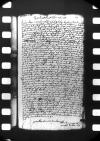 BCz, 1606, p. 219
BCz, 1606, p. 219
Dy gnad Gottes unssers hern Iesu Cristi.
Hochwirdiger in Got, freuntlicher und fielgelobter her Freund und Nachpar.
E(uer) L(ieb) sey zuvor mein gantz freuntlich dinst wes ich auch iederzeit mer liebs und guts vermag.
Bedanck ich auch gantz freuntlich E(uer) L(ieb) eigen gethane(n) ⌊⌋ den 3 Octobris aus der ⌊dagfard⌋ zu ⌊Graudenitz⌋ dy mitpringt ein entschuldigung des kurczen schreibens und pitten, das ich mer das vor lang zugethan gemute kegen meiner person in gunst und gutwilligkeit anfurenn wol. Welher [...] stain⌈[...][...] stain⌉ zugethane(n) gutwilligkeit ich mich gantz hochlich und freuntlich thu bedancken den mer auch solche lieb hochwirdiger zuscheczen auch aus danckparer gedechtnus nit zulassen, den ab alles papir so in ⌊Preussen⌋ auch an allen ander(n) orten moglich zumachen volgeschriben were und ist solcher freuntlichen dancksa stain⌈[sa]sa stain⌉gung der frolockung E(uer) L(ieb) glucklichen vortsetzung aber tra(n)slatio(n) kegen [...] stain⌈[...][...] stain⌉ gantz nit von note(n) den von E(uer) L(ieb) auch mein geliebter ⌊zukomender freund von Kolmanse⌋ noch zu eine(n) fiel hochern stand von Got ervordert wolt ich mir auch etwegen des sofiel mer erfreuen.
Wunsche herumb ⌊peden Ewern Lieben⌋ zu solcher erhohung auch dy grosse gnad und erleuchtnus Gottes des Heiligen stain⌈[igen]igen stain⌉ Geistes der pede E(uer) L(ieb) in seine(n) wegen leiten wol und dy gnad verleihen, dar die ernstliche lieb, frid und eintracht und also unssern gnedigsten hern gehorsam und wolfart erwnsche gotlichem name(n) zu ere gemeiner cristenheit und alle(n) disen stain⌈[sen]sen stain⌉ landen und leuten zuerparmung gotliches reichs der hegste name(n) und seligste stain⌈[te]te stain⌉ ervolge und zweifel gar nicht dy gnad Gottes wurd mit E(uer) L(ieb) sein dar durch alleint dy vorige zuneigung erhalten, besunder auch alle lieb und freuntscha stain⌈[scha]scha stain⌉fft auch nachparlicher willen wunschen und dy gunstige und freuntliche zune stain⌈[une]une stain⌉igung zu unssern dagen meiner erloschen den das sol sich E(uer) L(ieb) newlichen [...] stain⌈[...][...] stain⌉ zu mir versehen, das mein ⌊gemale⌋ mir auch noch nit anderst gestanden u[...] stain⌈[...][...] stain⌉ stehet, den wo ich E(uer) L(ieb) in allen zimlichem und ernstliche(n) fiel freuntlichen und nachparliche(n) willen erzeigen kunt und wust und also freuntlichen zudine(n), das ich [...] stain⌈[...][...] stain⌉ eren anderst durch meine(n) eigen firwitz und zunotu(n)g erfunden wolt, werden.
Wol den ane zweifel dis fridsamb gemute aus sundern gnaden Gottes herflo[...] stain⌈[...][...] stain⌉ so pit ich meine(n) liebsten Got durch Cristu(m) er wolle uns allen in solchem gnedig stain⌈[dig]dig stain⌉lich erhalten und an mir den mangel nit sein lassen wy ich auch an sein[...] stain⌈[...][...] stain⌉ gotlichen gnaden gar nicht zweifel und sol sich E(uer) L(ieb) zu einer aller gutwilligen stain⌈[igen]igen stain⌉ freuntschaft und dinst vertrosten, wy ich den dem erenfesten und edeln hern ⌊Ach stain⌈[ch]ch stain⌉acio Czeme(n)⌋, Danzker kastellan, y(n) weitter E(uer) L(ieb) auch mu(n)tlich anzuzeigen gepoten stain⌈[en]en stain⌉ den E(uer) L(ieb) auch also von meinent wegen glauben sol y(n) in sol aber ab denen amptleut aber verwanten zu peder seit was unnachparlichs des ich doch [...] stain⌈[...][...] stain⌉ treffen wil und pey meine(n) amptleute(n) sowol muglich darvor sein dort sy [...] stain⌈[...][...] stain⌉ ursach gewen sollen ... illegible⌈...... illegible⌉ ferfile(?) so er sich ein ieder das selbige mit freuntschafft stain⌈[afft]afft stain⌉ wie es sich gepuret. Wil mich beschlislich gantz und gar E(uer) L(ieb) erpitens getros[...] stain⌈[...][...] stain⌉ und daran gar nichts zweifeln das sich E(uer) L(ieb) zu mir auch versehen sol.
Be[...] stain⌈[...][...] stain⌉ so mich hiemit in E(uer) L(ieb) lieb und freuntschafft wunsche unn pitte auch E(uer) L(ieb) Got den allmechtigen langewiche gesuntheit / und alles was E(uer) L(ieb) zu sel und [...] stain⌈[...][...] stain⌉ amt nutzen. Mein liebste ⌊gemahel⌋ ist hoch erfreuet, das E(uer) L(ieb) so nahend zu uns stain⌈[ns]ns stain⌉ kum(m)e(n), wunscht fiel gluckselige wolfart mit freuntlicher und zimlicher erpiten stain⌈[en]en stain⌉ befilet sich E(uer) L(ieb) irem freuntlichen und lieben peichtvatter(n).


 BCz, 1606, p. 222
BCz, 1606, p. 222